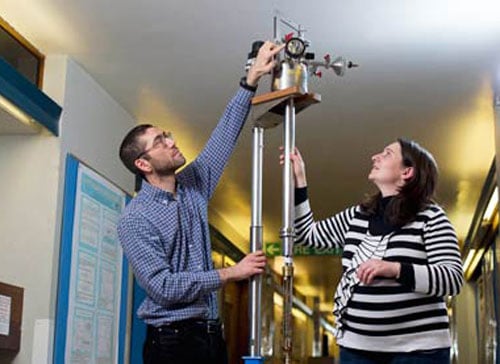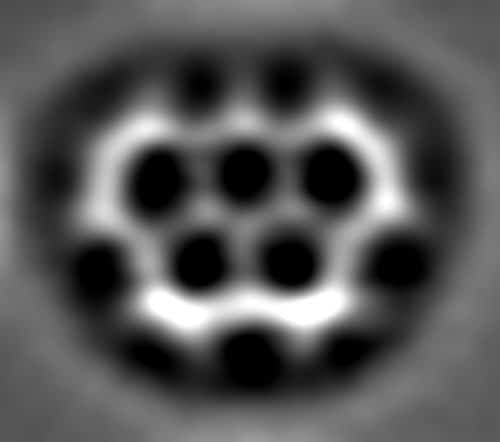By Michael Banks
From determining the “equation of state” of a ponytail to a zombie film shot at CERN, the world of physics has had its fair share of bizarre stories this year. Here is our pick of the best from the physicsworld.com blog.
Physicists ponder flowering masonry
Efflorescence on a masonry wall (Courtesy: Mattes)
One thing you can say about most houses is that they are solid – built from bricks or cement blocks. But there is a downside to such solid construction. Masonry – and older bricks in particular – tend to suck-up moisture from the ground. One symptom of rising damp is efflorescence (or “flowering out”), which refers to crystals of salts that grow out from the surface of masonry as the damp evaporates into the air. However, rather than emerging as a uniform coating of salt, the crystals tend to appear in clumps – but exactly why remained a mystery. That was until February when Marc Prat and colleagues at the University of Toulouse, France, performed experiments and computer simulations suggesting that salt flowers form where “efficient pathways” emerge at the surface. Once a crystal is established on the surface, its presence increases the flow of water through that particular pathway, further depriving surrounding less-efficient pathways of liquid. The result is regions with large crystals, and other regions with no salt. Mystery solved.
Physicists in the UK took the whole concept of “fringe science” to a new level in February by studying that hairstyle of choice for men and women of a certain disposition – the ponytail. Raymond Goldstein of the University of Cambridge, Robin Ball of the University of Warwick and Patrick Warren from shampoo-maker Unilever claim that the shape of a ponytail is defined by a competition between gravity, the elasticity of individual hairs and their mutual interactions (Phys. Rev. Lett. 108 078101). And because a ponytail can contain as many as 100,000 hairs, the problem is best addressed using statistical physics. The researchers even derived an “equation of state” for a ponytail that includes what they dub a “Rapunzel number” – a dimensionless measure of ponytail length. The equation was then used to predict how the shape of a ponytail varies with length, with a real ponytail requiring an additional term that reflects hair getting frizzier as it grows longer.
Unravelling the physics of curling

The physics of hair didn’t stop there. In May Andrew Callan-Jones of the University of Montpellier, France, and colleagues at the University of Paris made a theoretical and experimental study of how things such as hair, plant tendrils and even red blood cells curl and uncurl. Despite these processes being all around us, it turns out that physicists have a relatively poor understanding of the dynamics of curling. Callan-Jones and colleagues studied how a steel strip curls by taking images – at a rate of 7000 frames per second – as it does so. The behaviour was successfully described by a mathematical model created by the team and then incorporated into a computer simulation. The researchers even applied their new-found knowledge of curling to the bursting of red blood cells – which is caused by certain nasty bacteria and involves the curling back of the cell membrane.

University of Exeter researchers Saverio Russo and Monica Craciun.
(Courtesy: University of Exeter)
A day rarely goes by here at physicsworld.com HQ when the word graphene is not mentioned; after all, it is the “wonder material”, with a seemingly endless list of bizarre properties and a plethora of potential applications. But it seems that researchers at the University of Exeter in the UK ran out of suitable, and indeed imaginative, names when describing their new graphene-based material. In May the researchers, led by physicist Monica Craciun, claimed to have created the most transparent, lightweight and flexible version of graphene yet by sandwiching molecules of ferric chloride between two layers of graphene (Adv. Mat. 10.1002/adma.201200489). So what did they call their exciting new material? Behold “GraphExeter”. “[The name] clearly delivers two key messages: the material is based on graphene and it was synthesized and characterized at Exeter,” Craciun told physicsworld.com. She also rejected suggestions from “some Internet blogs” for the slimmed-down “GraphEx”.

In what seemed like an impeccably well timed research finding, researchers at the Royal Society of Chemistry, the University of Warwick in the UK and IBM Research in Zurich released an image in late May of a new molecule they had synthesized that had an uncanny likeness to the five rings reminiscent of an event that happened in London this summer (no prizes for guessing which one). Given the resemblance, the press were all over it: “Scientists create smallest ever version of Olympics logo” screamed a headline in the Daily Mail. However, the team, led by David Fox from Warwick, had already synthesized the compound, which is dubbed Olympicene and has the chemical formula C19H12, back in 2011. What the researchers did that was new was to make an image of Olympicene with the help of an atomic force microscope at the IBM labs. The researchers are still yet to hear from the International Olympic Committee given how protective they can be of their image rights.
The lightest material in the world

(Courtesy: TUHH)
In July two teams of researchers from Kiel University and Hamburg University of Technology, both in Germany, fabricated a material they claim to be the lightest in the world. Dubbed Aerographite, it is a 3D network of porous carbon nanotubes and weighs only 0.2 mg per cubic centimetre, making it 75 times lighter than Styrofoam. Most lightweight materials can easily be compressed but become weak when exposed to large amounts of stress. Aerographite, however, actually becomes stronger. Aerographite weighs four times less than the hitherto lightest material in the world – a nickel material that was revealed only six months ago. The researchers say that aerographite could have innumerable applications – it could be used to make lightweight lithium-ion batteries, to build satellites and even in water-purification systems.
It seems that Fermilab physicist Dan Hooper finally hit the big time this year. Not for his latest theory on the Higgs boson or dark matter but rather through his involvement in a band called the Congregation. Guitarist Hooper formed the band around three years ago and it now consists of a drummer, bassist, singer, hornist and keyboard player. On 9 August the 1960s-style soul band opened a joint gig by US rock bands Garbage and the Flaming Lips in Madison, Wisconsin. Not resting on their laurels, band members released a new album in September. Hooper, who goes by the stage name Charlie Wayne and also writes the band’s lyrics, says that they steer clear of anything physics-related as well as any rock-band antics. “We don’t do a lot of smashing guitars and such anymore,” Hooper told physicsworld.com.
A group of PhD students have made a feature-length zombie film at the CERN particle-physics lab. Called Decay, the 75 min film follows a group of students – played by actual physicists – who are desperately trying to escape the lab while being pursued by a bunch of bloodthirsty maintenance workers who have turned into zombies after exposure to the newly discovered Higgs boson. Writer and director Luke Thompson, a PhD student at the University of Manchester in the UK, came up with the idea back in 2010. Armed with a budget of just £2000 of his own cash but with no previous experience in film-making, he assembled a cast and crew of 20 who have spent the past two years filming in basement level tunnels at CERN, which he says have a “dark, creepy atmosphere”. The film has not been authorized or endorsed by CERN, but Thompson says the lab has a “relaxed attitude” towards the project, seeing the “fun side of it”.

(Courtesy: Bletchley Park/Winning Moves)
And finally, for those of you looking for a last-minute Christmas present, how about the Alan Turing Monopoly board? Centred around the life of the mathematician and computer scientist who played a key role at the UK government’s Bletchley Park estate in deciphering German army messages during the Second World War, Alan Turing Monopoly costs a bargain £29.99. The new board is based on one housed in the Bletchley Park Museum that was hand-drawn in 1950 by William Newman – the son of Turing’s Bletchley Park mentor Max Newman. All the banknotes in the new version feature Turing’s face and instead of the usual London, Berlin or Atlantic City haunts occupying the squares, the board features locations that had an important part in Turing’s life such as Kings College, Cambridge. The special edition also includes a copy of the original hand-drawn board, complete with Newman’s own rules, as well as historical references for all the places mentioned.
You can be sure of more quirky stories from the world of physics next year. See you in 2013!



